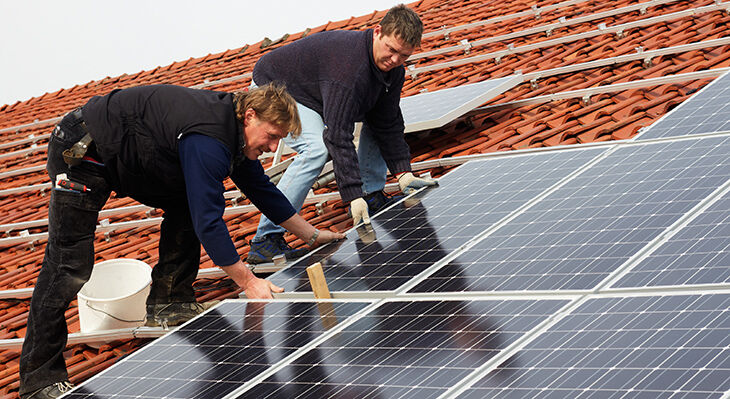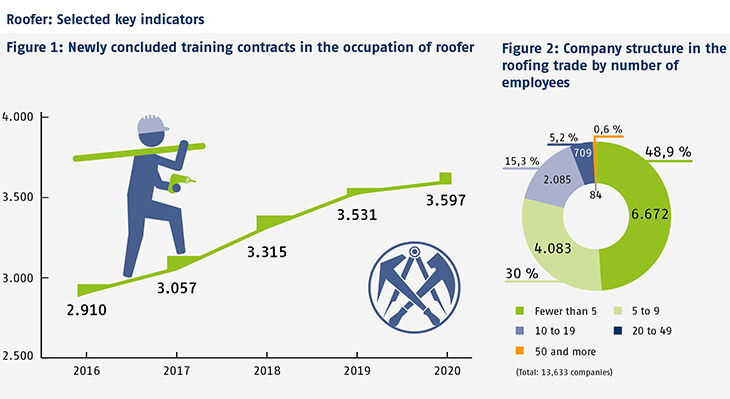Profile of an occupation – roofer
Roofers do much more than roofing. They carry out other works on all areas of the roof and exterior walls of a building, and also install energy measures and solar thermal and photovoltaic systems. This description of the occupation explains the extent to which climate protection forms part of the training occupation. It also shows which trends are emerging and how trainee numbers are developing.

Cladding and climate protection
Roofers work on every part of a building from the cellar to the rooftop. Lower areas must be sealed against penetration by dampness and ground water. Roof coverings include slabs, shingles, reed thatch, metal, slates and tiles. The competence profile of a roofer is extensive. Roofers need to ensure that roofs are wind resistant and weatherproof. They build wooden constructions for trusses, prepare sub-constructions, install devices to drain surface water and erect lightning protection systems. Their field of activity encompasses the installation of skylights and dormers and the construction of roof frames and other sub-assemblies. They also carry out maintenance, renovation and modernisation work. While energy-efficient refurbishment is becoming increasingly important for roofers in the craft trades sector, thermal insulation and the installation of photovoltaic and solar panels are also growing in significance alongside another task which is also beneficial to climate protection – roofers help to create living space for humans and animals by preparing flat roof spaces for gardens and ponds. Green roofs improve the local climate and reduce the prevalence of urban heat islands. Vegetation regulates the temperature of buildings, which lose up to ten percent of their energy via the roof. Green roofs are also able to store moisture by retaining as much as 90 percent of precipitation. Most of this water will evaporate, whilst the rest gradually flows away. Germany is a world leader in green roofs. The amount of space dedicated to roof greening in the country is estimated to be between 100 and 150 million m2.
Special term – verge
The verge is the visible face of a pitched or pent roof, i.e. the sloping finish which runs along the gable. It is where the gable, roof frame and covering meet. The name reflects the fact that the roof can no longer be walked upon at this point.
Trends
Digitalisation is changing roofing and adding further requirements. New technologies can facilitate work and may open up fresh opportunities.
Drones – drones with camera systems are being increasingly deployed to survey or inspect roofs and façades. This approach allows overview images or detailed pictures to be taken of damage without any need for scaffolding or lifting platforms.
3D laser scanning – roofs are surveyed with a laser scanner to obtain a three-dimensional view. This enhances process security and accuracy of measurement and permits dimensions to be checked and understood more effectively. Results also provide the basis for the realisation of BIM (building information modelling) projects.
Leakage detectors – flat roofs are usually closed systems which need to remain completely watertight. Environmental influences or animals may create minor leaks over years. Sensors are able to indicate if moisture has penetrated and can thus help with the identification of leakages.
Intelligent Green Building – automatic opening and closure of windows, rain sensors, shutter and awning control systems and emergency functions all form part of an overall energy efficiency concept.
Rising number of newly concluded contracts
Craft trade occupations saw a significant decline in the number of new training contracts concluded during the first year of the pandemic (minus 7.5 percent in 2020 vis-à-vis 2019). Roofing, however, bucked this trend by recording 3,597 new contracts over the same period. This figure even represented a rise of 1.8 percent compared to 2019 (cf. Figure 1). One possible explanation for this positive trend could be that work was able to continue in a virtually unrestricted fashion, despite the pandemic.
The roofing trade largely consists of small firms. In 2018, just under half of 13,633 companies (6,672) had fewer than five employees (cf. Figure 2).

A particular regional characteristic
Reed thatch technology is one of five specialisms which trainees may select (cf. Information Box “At a glance”). Reed thatch roofs are mainly found in northern Germany, where they form a vital part of the landscape. The idea of using natural building materials and of following cultural values has been experiencing a renaissance for some years. Greater significance is now being attached to reed thatch as an alternative roofing cover. The thatch is fixed to the roof frame in bundles via processes such as sewing, binding or screwing. It is then beaten into shape with a knocking board.
At a glance
- Last updated: 2016
- Duration of training: 3 years
- Responsibility: Craft trades sector
- Training structure: Training occupation with a choice of five specialisms:
- Roofing technology
- Sealing technology
- External wall cladding technology
- Energy technology for roofs and walls
- Reed thatch roofing techniques
- DQR reference level: 4
- Advanced vocational training: Master craftsman qualification in roofing; state-certified technician in relevant specialisms
- BIBB website page on the occupation
- German roofing trade website on the training: dachdeckerdeinberuf.de
(All links as of: 04/08/2021)
Source: Quelle: Zentralverband des Deutschen Dachdeckerhandwerks e. V.
(Compiled by Arne Schambeck)
Translation from the German original (published in BWP 3/2021): Martin Kelsey, GlobalSprachTeam, Berlin